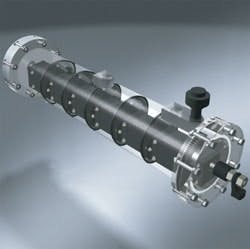For many years the use of gaseous chlorine at water treatment plants has been an effective method of disinfection. In fact, it is currently the most commonly used disinfectant throughout the U.S. However, in recent years the safety of chlorine gas has come under increased scrutiny.
Dangerous gas
At low levels, chlorine gas can cause eye, skin and respiratory irritation, while exposure in high enough doses can be fatal. In addition to the side effects related to chlorine gas exposure, the nature of the gas allows migration to distances well beyond the point of release.
The use of gaseous chlorine also produces disinfection byproducts, (DBPs) such as trihalomethanes (THMs) and haloacetic acids. Concerns over the presence of these DBPs in drinking water have recently become apparent through the introduction of several U.S. EPA drinking water regulations. Maintaining compliance with these regulations has been difficult for many drinking water utilities, forcing the utility to either make treatment modifications at the plant, or find disinfection alternatives.
Chloramines are widely considered the best disinfectant for DBP control. However, a 2004 study (Plewa et al., 2004) suggests that the DBPs formed from chloramines are potentially more harmful to the consumer than those formed by chlorine. Ozone and UV radiation are other alternative disinfectants that can be used for DBP reduction. However, these options cannot maintain the required disinfectant residual in the transmission system. Therefore, it is impractical to use ozone or UV radiation as the sole disinfectant on a public drinking water supply.
On-site sodium hypochlorite generation offers several advantages over gaseous chlorine for disinfection. First, the disinfectant is produced and stored in liquid form. Therefore, there is no danger of large-scale gas leaks from high-pressure chlorine cylinders. On-site sodium hypochlorite generating system users do not need to develop and maintain a U.S. EPA-required Risk Management Plan (RMP). HAZMAT training also is not required for handling the disinfectant, and self-contained breathing apparatuses are not necessary. In addition, on-site sodium hypochlorite disinfection systems do not suppress finished water pH to the extent seen with the use of gaseous chlorine disinfection. Thus reducing the amount of pH adjustment chemical (i.e., lime or caustic) necessary before the distribution of finished water.
A new system
In 2002, recognizing the potential hazards associated with the use of gaseous chlorine, the City of Hickory, N.C., began investigating replacement disinfection systems for its 32 mgd water treatment plant, which serves a population of more than 90,000. The City commissioned the Spartanburg, S.C., office of Hayes, Seay, Mattern & Mattern, an architectural and engineering services firm based in Roanoke, Va., to replace its gaseous chlorine disinfection system. This system was the same type of disinfection utilized at the plant when it was originally constructed. The firm selected the ClorTec CT-750 on-site sodium hypochlorite generating system from Severn Trent Services .
The new disinfection system was put into operation in early 2003, making it the first system of its kind in the state. It is fully automated, but also includes manual operation features. With a generating capacity of 750 lb/day, the system produces a 0.8% hypochlorite solution using solar salt in the process. Four tanks each provide 5,500 gallons of storage capacity, with one remaining empty for emergency storage of commercial-grade 15% sodium hypochlorite.
Generating sodium hypochlorite on site is a simple and straightforward process that uses three common consumables: salt, water and electricity. The City of Hickory’s disinfection system operates by feeding softened water into a brine dissolver. The salt dissolves to form a brine solution, which is further diluted to the desired salt solution. The salt solution is then passed through electrolytic cells, which apply a low voltage DC current to the brine to produce the sodium hypochlorite. The disinfectant is then safely stored in a day tank. Then, when it reaches the low-level set point, the system automatically restarts to replenish its supply. Five centrifugal pumps inject the hypochlorite as needed.
The City of Hickory has been able to reduce the amount of caustic required at the plant. While gaseous chlorine has a low pH and will depress the pH of drinking water, onsite-generated sodium hypochlorite disinfection has an alkaline pH and tends to increase the pH of drinking water. The use of gaseous chlorine, especially in conjunction with a pH lowering coagulant, generally requires significant quantities of caustic or other alkaline chemicals to adjust the pH to the proper range for the distribution system. The alkaline pH of the on-site sodium hypochlorite generating system helps to minimize the need for pH adjusting chemicals such as caustic or lime. Since the installation, the caustic requirement has decreased by approximately 30%.
By almost any measure, the on-site sodium hypochlorite generating system installed at the City of Hickory Water Treatment Plant has met the City’s expectations. On-site generation eliminates the use of the hazardous disinfection chemicals used in gaseous chlorine disinfection. In addition, ongoing operational efficiencies with low, predictable maintenance have provided noticeable cost savings.


